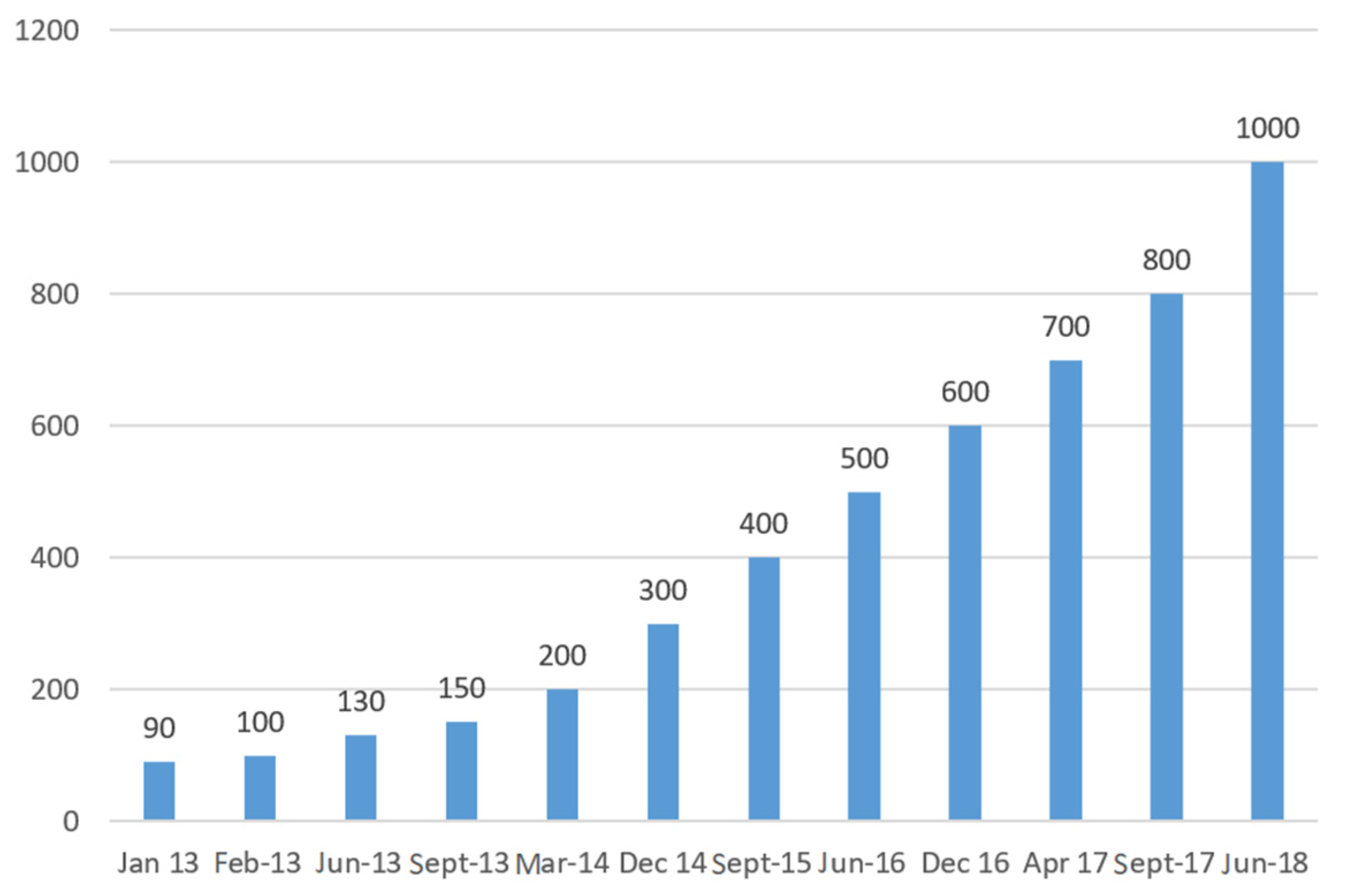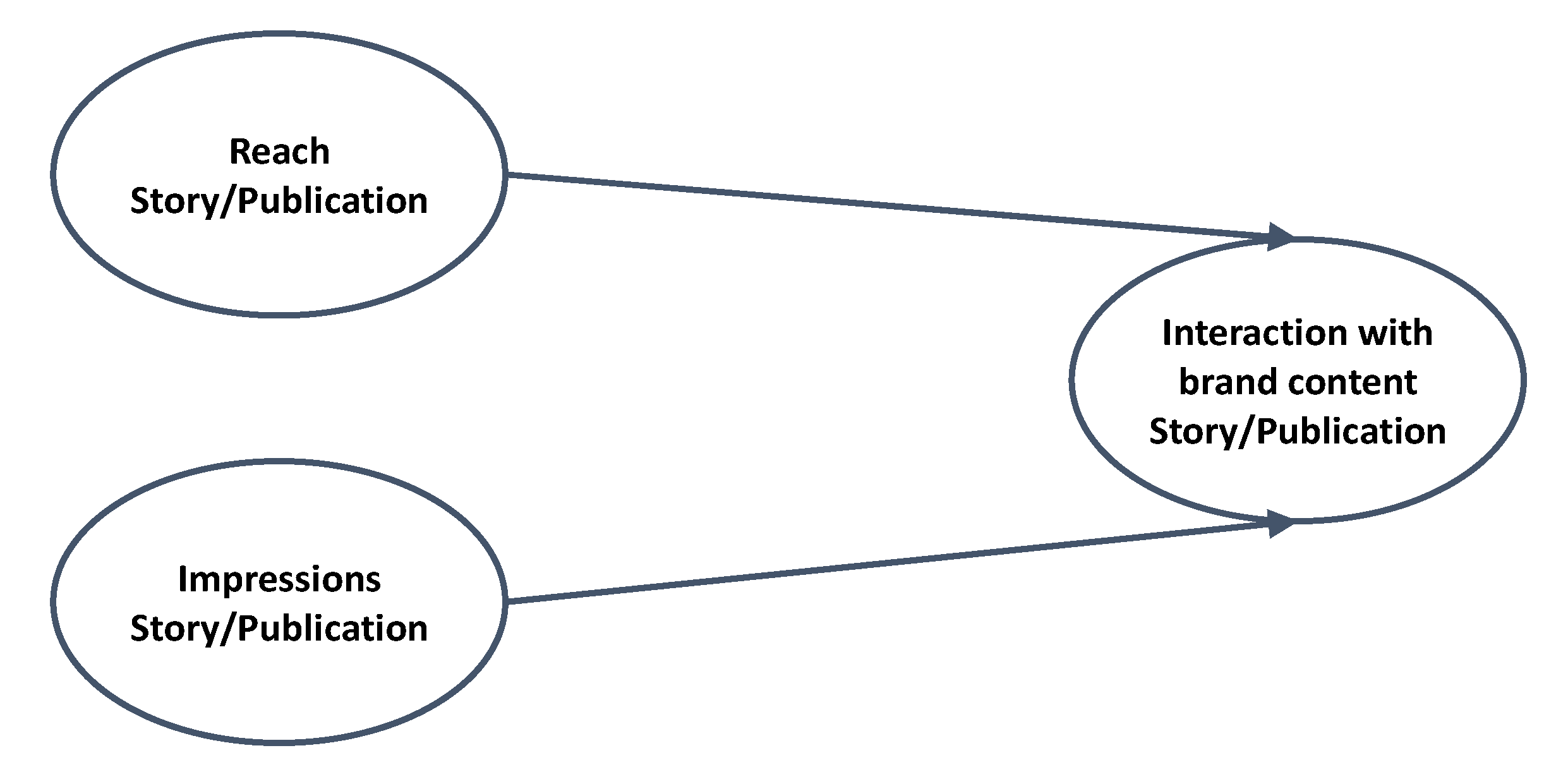The Brand-Generated Content Interaction of Instagram Stories and Publications: A Comparison between Retailers and Manufacturers
Abstract
1. Introduction
2. Instagram Publications/Stories and Brand-Generated Content in Social Media
2.1. Instagram Publications and Stories
2.2. Instagram Shopping
2.3. Brand-Generated Content in Social Media
2.4. Interaction with the Brand in Social Media
3. Material and Methods
3.1. Research Questions and Theoretical Model
3.2. Data Collection
3.3. Measures
4. Results
4.1. Reliability
4.2. Structural Model
5. Discussion
6. Limitations and Future Research
Author Contributions
Funding
Acknowledgments
Conflicts of Interest
References
- Ilich, K.L.; Hardey, M. ‘It’s all about the packaging’: Investigation of the motivations, intentions, and marketing implications of sharing photographs of secondary packaging on Instagram. Inf. Commun. Soc. 2020, 23, 1–19. [Google Scholar] [CrossRef]
- Demiray, M.; Burnaz, S. Exploring the impact of brand community identification on Facebook: Firm-directed and self-directed drivers. J. Bus. Res. 2019, 96, 115–124. [Google Scholar] [CrossRef]
- Lee, D.; Hosanagar, K.; Nair, H.S. Advertising content and consumer engagement on social media: Evidence from facebook. Manag. Sci. 2018, 64, 5105–5131. [Google Scholar] [CrossRef]
- Dabbous, A.; Barakat, K.A. Bridging the online offline gap: Assessing the impact of brands’ social network content quality on brand awareness and purchase intention. J. Retail. Consum. Serv. 2020, 53, 101966–101976. [Google Scholar] [CrossRef]
- Hoffman, D.; Fodor, M. Can you measure the roi of your social media marketing? MIT Sloan Manag. Rev. 2010, 52, 41. [Google Scholar]
- Cvijikj, I.P.; Michahelles, F. Understanding the user generated content and interactions on a Facebook brand page. Int. J. Soc. Humanist. Comput. 2013, 2, 118–140. [Google Scholar] [CrossRef]
- Wang, Z.; Kim, H.G. Can Social Media Marketing Improve Customer Relationship Capabilities and Firm Performance? Dynamic Capability Perspective. J. Interact. Mark. 2017, 39, 15–26. [Google Scholar] [CrossRef]
- Mochon, D.; Johnson, K.; Schwartz, J.; Ariely, D. What are likes worth? a facebook page field experiment. J. Mark. Res. 2017, 54, 306–317. [Google Scholar] [CrossRef]
- Rutz, O.J.; Bucklin, R.E. From generic to branded: A model of spillover in paid search advertising. J. Mark. Res. 2011, 48, 87–102. [Google Scholar] [CrossRef]
- Nisar, T.M.; Prabhakar, G.; Ilavarasan, P.V.; Baabdullah, A.M. Up the ante: Electronic word of mouth and its effects on firm reputation and performance. J. Retail. Consum. Serv. 2020, 53. [Google Scholar] [CrossRef]
- Smith, A.N.; Fischer, E.; Yongjian, C. How does brand-related user-generated content differ across youtube, facebook, and twitter? J. Interact. Mark. 2012, 6, 102–113. [Google Scholar] [CrossRef]
- Kupfer, A.-K.; der Holte, N.P.v.; Kübler, R.V.; Hennig-Thurau, T. The Role of the Partner Brand’s Social Media Power in Brand Alliances. J. Mark. 2018, 82, 25–44. [Google Scholar] [CrossRef]
- Hwang, J.; Choi, L. Having fun while receiving rewards?: Exploration of gamification in loyalty programs for consumer loyalty. J. Bus. Res. 2020, 106, 365–376. [Google Scholar] [CrossRef]
- Kumar, V.; Pansari, A. Competitive Advantage through Engagement. J. Mark. Res. 2016, 53, 497–514. [Google Scholar] [CrossRef]
- Gorlier, T.; Michel, G. How special rewards in loyalty programs enrich consumer-brand relationships: The role of self-expansion. Psychology & Marketing 2020, 37, 564–577. [Google Scholar] [CrossRef]
- de Vries, L.; Gensler, S.; Leeflang, P.S.H. Rffects of traditional advertising and social messages on brand-building metrics and customer acquisition. J. Mark. 2017, 81, 1–15. [Google Scholar] [CrossRef]
- Yuki, T. What Makes Brands’ Social Content Shareable on Facebook? An Analysis that Demonstrates the Power of Online Trust and Attention. J. Advert. Res. 2015, 55, 458–470. [Google Scholar] [CrossRef]
- Kaplan, A.M.; Haenlein, M. Users of the world, unite! The challenges and opportunities of Social Media. Bus. Horiz. 2010, 53, 59–68. [Google Scholar] [CrossRef]
- Maity, M.; Gupta, S. Mediating effect of loyalty program membership on the relationship between advertising effectiveness and brand loyalty. J. Mark. Theor. Pract. 2016, 24, 462–481. [Google Scholar] [CrossRef]
- Dhar, V.; Chang, E.A. Does Chatter Matter? The Impact of User-Generated Content on Music Sales. J. Interact. Mark. 2009, 23, 300–307. [Google Scholar] [CrossRef]
- Sabate, F.; Berbegal-Mirabent, J.; Cañabate, A.; Lebherz, P.R. Factors influencing popularity of branded content in Facebook fan pages. Eur. Manag. J. 2014, 32, 1001–1011. [Google Scholar] [CrossRef]
- Colicev, A.; Malshe, A.; Pauwels, K.; O’Connor, P. Improving consumer mindset metrics and shareholder value through social media: The different roles of owned and earned media. J. Mark. 2018, 82, 37–56. [Google Scholar] [CrossRef]
- Bleier, A.; Harmeling, C.M.; Palmatier, R.W. Creating Effective Online Customer Experiences. J. Mark. 2018, 83, 98–119. [Google Scholar] [CrossRef]
- Stephen, A.T.; Galak, J. The effects of traditional and social earned media on sales: A study of a microlending marketplace. J. Mark. Res. 2012, 49, 624–639. [Google Scholar] [CrossRef]
- Ashley, C.; Tuten, T. Creative strategies in social media marketing: An exploratory study of branded social content and consumer engagement. Psychol. Mark. 2015, 32, 15–27. [Google Scholar] [CrossRef]
- Goh, K.-Y.; Heng, C.-S.; Lin, Z. Social media brand community and consumer behavior: Quantifying the relative impact of user-and marketer-generated content. Inf. Syst. Res. 2013, 24, 88–107. [Google Scholar] [CrossRef]
- Chaabane, A.M.; Pez, V. Make me feel special: Are hierarchical loyalty programs a panacea for all brands? The role of brand concept. J. Retail. Consum. Serv. 2017, 38, 108–117. [Google Scholar] [CrossRef]
- Kusumasondjaja, S.; Tjiptono, F. Endorsement and visual complexity in food advertising on Instagram. Internet Res. 2019, 29, 659–687. [Google Scholar] [CrossRef]
- de Veirman, M.; Hudders, L. Disclosing sponsored Instagram posts: The role of material connection with the brand and message-sidedness when disclosing covert advertising. Int. J. Advert. 2020, 39, 94–130. [Google Scholar] [CrossRef]
- Rehnen, L.-M.; Bartsch, S.; Kull, M.; Meyer, A. Exploring the impact of rewarded social media engagement in loyalty programs. J. Serv. Manag. 2017, 28, 305–328. [Google Scholar] [CrossRef]
- Arora, A.; Bansal, S.; Kandpal, C.; Aswani, R.; Dwivedi, Y. Measuring social media influencer index- insights from facebook, Twitter and Instagram. J. Retail. Consum. Serv. 2019, 49, 86–101. [Google Scholar] [CrossRef]
- Song, Y.-A.; Lee, S.Y.; Kim, Y. Does mindset matter for using social networking sites?: Understanding motivations for and uses of Instagram with growth versus fixed mindset. Int. J. Advert. 2019, 38, 886–904. [Google Scholar] [CrossRef]
- Thelander, A.; Cassinger, C. Brand New Images? Implications of Instagram Photography for Place Branding. Media Commun. 2017, 5, 6–14. [Google Scholar] [CrossRef]
- Vinhas, A.S.; Bowman, D. Online/offline information search patterns and outcomes for services. J. Serv. Mark. 2019, 31, 753–770. [Google Scholar] [CrossRef]
- Mayar, V.; Ramsey, G. Digital Impact: The Two Secrets to Online Marketing Success; John Wiley & Sons: Hoboken, NJ, USA, 2011. [Google Scholar]
- Lehu, J. Branded Enterntainment; Kogan Page: London, UK, 2007. [Google Scholar]
- Malhotra, A.; Malhotra, C.K.; See, A. How to Create Brand Engagement on Facebook. MIT Sloan Manag. Rev. 2013, 54, 18–20. [Google Scholar]
- Liu-Thompkins, Y.; Shrum, L.J. What is interactivity and is it always such a good thing? implications of definition, person, and situation for the influence of interactivity on advertising effectiveness. J. Advert. 2002, 31, 53–64. [Google Scholar]
- Meire, M.; Hewett, K.; Ballings, M.; Kumar, V.; van den Poel, D. The role of marketer-generated content in customer engagement marketing. J. Mark. 2019, 83, 21–42. [Google Scholar] [CrossRef]
- Podsakoff, P.M.; MacKenzie, S.B.; Lee, J.-Y.; Podsakoff, N.P. Common method biases in behavioral research: A critical review of the literature and recommended remedies. J. Appl. Psychol. 2003, 88, 879–903. [Google Scholar] [CrossRef]
- Henseler, J. Bridging Design and Behavioral Research With Variance-Based Structural Equation Modeling. J. Advert. 2017, 46, 178–192. [Google Scholar] [CrossRef]
- Jarvis, C.; Mackenzie, S.; Podsakoff, P. A Critical Review of Construct Indicators and Measurement Model Misspecification in Marketing and Consumer Research. J. Consum. Res. 2003, 30, 199–218. [Google Scholar] [CrossRef]
- Hu, L.; Bentler, P.M. Cutoff criteria for fit indexes in covariance structure analysis: Conventional criteria versus new alternatives. Struct. Equ. Model. A Multidiscip. J. 1999, 6, 1–55. [Google Scholar] [CrossRef]
- Henseler, J.; Ringle, C.M.; Sarstedt, M. A new criterion for assessing discriminant validity in variance-based structural equation modeling. J. Acad. Mark. Sci. 2014, 43, 115–135. [Google Scholar] [CrossRef]
- Voorhees, C.M.; Brady, M.K.; Calantone, R.; Ramirez, E. Discriminant validity testing in marketing: An analysis, causes for concern, and proposed remedies. J. Acad. Mark. Sci. 2015, 44, 119–134. [Google Scholar] [CrossRef]
- Apiraksattayakul, C.; Papagiannidis, S.; Alamanos, E. Shopping via Instagram: The Influence of Perceptions of Value, Benefits and Risks on Purchase Intentions. Int. J. Online Mark. 2017, 7, 1–20. [Google Scholar] [CrossRef]
- Fu, D.; Hong, Y.; Wang, K.; Fan, W. Effects of membership tier on user content generation behaviors: Evidence from online reviews. Electron. Commer. Res. 2018, 18, 457–483. [Google Scholar] [CrossRef]
- Kanuri, V.K.; Chen, Y.; Sridhar, S. Scheduling content on social media: Theory, evidence, and application. J. Mark. 2018, 82, 89–108. [Google Scholar] [CrossRef]
- Kumar, A.; Bezawada, R.; Rishika, R.; Janakiraman, R.; Kannan, P.K. From social to sale: The effects of firm-generated content in social media on customer behavior. J. Mark. 2016, 80, 7–25. [Google Scholar] [CrossRef]
- Kim, T.; Barasz, K.; John, L.K. Why Am I Seeing This Ad? The Effect of Ad Transparency on Ad Effectiveness. J. Consum. Res. 2019, 45, 906–932. [Google Scholar] [CrossRef]


| Firm A Manufacturer | Firm B Retailer | Firm C Manufacturer | Firm D Retailer | |
|---|---|---|---|---|
| 200 Observations: 100 Stories and 100 Publications | 200 Observations: 100 Stories and 100 Publications | 200 Observations: 100 Stories and 100 Publications | 200 Observations: 100 Stories and 100 Publications | |
| Stories | ||||
| Reach | n.s. | 0.69 (3.28) *** | 0.23 (4.52) *** | n.s. |
| Impressions | n.s. | n.s. | n.s. | n.s. |
| Publications | ||||
| Reach | n.s. | n.s. | n.s. | n.s. |
| Impressions | 0.61 (4.87) *** | 0.61 (2.54) *** | 0.81 (2.44) *** | 0.35 (2.92) *** |
Publisher’s Note: MDPI stays neutral with regard to jurisdictional claims in published maps and institutional affiliations. |
© 2020 by the authors. Licensee MDPI, Basel, Switzerland. This article is an open access article distributed under the terms and conditions of the Creative Commons Attribution (CC BY) license (http://creativecommons.org/licenses/by/4.0/).
Share and Cite
Sánchez-Cobarro, P.d.H.; Molina-Castillo, F.-J.; Alcazar-Caceres, C. The Brand-Generated Content Interaction of Instagram Stories and Publications: A Comparison between Retailers and Manufacturers. J. Theor. Appl. Electron. Commer. Res. 2021, 16, 513-524. https://doi.org/10.3390/jtaer16030031
Sánchez-Cobarro PdH, Molina-Castillo F-J, Alcazar-Caceres C. The Brand-Generated Content Interaction of Instagram Stories and Publications: A Comparison between Retailers and Manufacturers. Journal of Theoretical and Applied Electronic Commerce Research. 2021; 16(3):513-524. https://doi.org/10.3390/jtaer16030031
Chicago/Turabian StyleSánchez-Cobarro, Paloma de H., Francisco-Jose Molina-Castillo, and Cristina Alcazar-Caceres. 2021. "The Brand-Generated Content Interaction of Instagram Stories and Publications: A Comparison between Retailers and Manufacturers" Journal of Theoretical and Applied Electronic Commerce Research 16, no. 3: 513-524. https://doi.org/10.3390/jtaer16030031
APA StyleSánchez-Cobarro, P. d. H., Molina-Castillo, F.-J., & Alcazar-Caceres, C. (2021). The Brand-Generated Content Interaction of Instagram Stories and Publications: A Comparison between Retailers and Manufacturers. Journal of Theoretical and Applied Electronic Commerce Research, 16(3), 513-524. https://doi.org/10.3390/jtaer16030031






